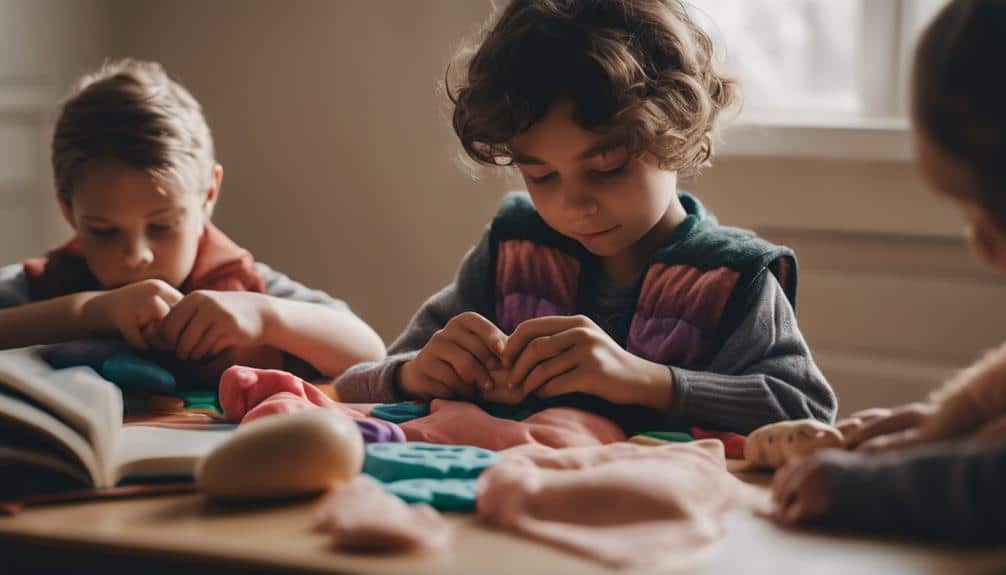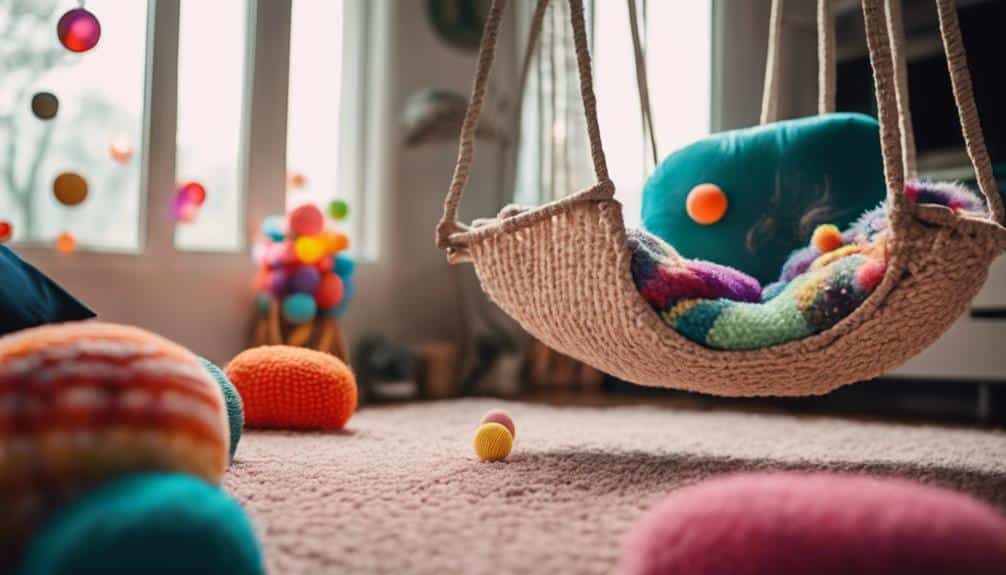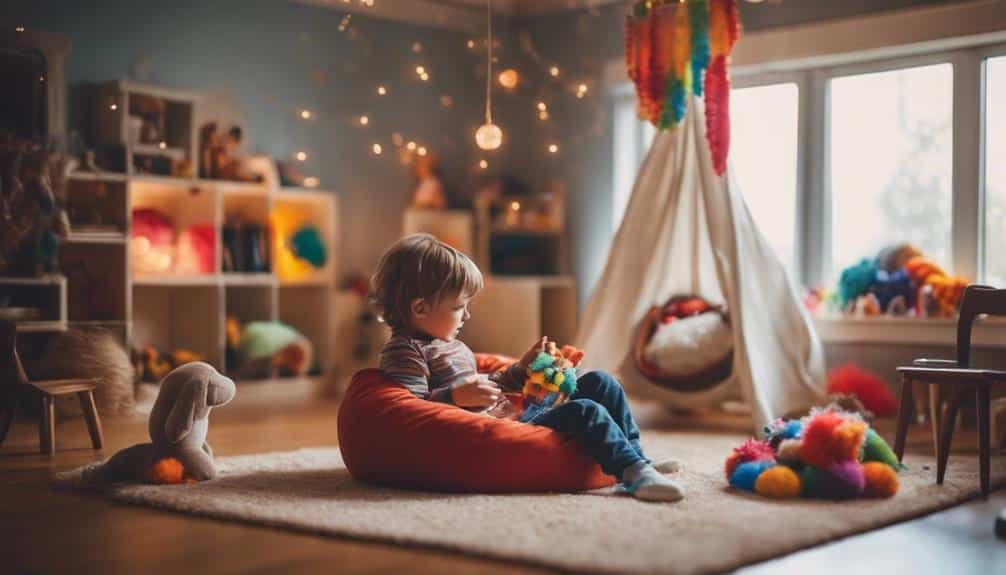Supporting children with sensory processing disorders is crucial for their development and well-being. Creating sensory nooks at home is essential to providing these children with a comforting and supportive environment. By incorporating simple sensory integration strategies, such as setting up a dedicated sensory corner with soft furnishings and engaging in proprioceptive activities like heavy lifting or trampoline jumps, caregivers can cater to the unique sensory needs of individuals.
These activities not only promote self-regulation and emotional stability but also have the potential for transformative impact on daily living and overall well-being. Through the deliberate construction of sensory nooks within the home, caregivers empower children to navigate their sensory experiences more effectively, fostering autonomy and confidence in their abilities to cope with sensory challenges. As we delve deeper into the efficacy of these approaches, we recognize the profound significance of sensory nooks in providing a nurturing environment where children can thrive despite their sensory processing difficulties.
Key Takeaways
- Create a sensory corner with soft furnishings and bean bag chairs for deep pressure input.
- Incorporate proprioceptive activities like heavy work and dynamic movement for emotional regulation.
- Use deep pressure techniques with weighted blankets or snug armchairs for sensory regulation.
- Engage in vestibular and oral-motor exercises with balance boards and chewy toys for enhanced sensory processing.
Sensory Nook Corner Setup
Creating a sensory corner frequently involves a deliberate selection of elements designed to provide both stimulation and a serene retreat, catering to the diverse sensory needs of children. This specialized space serves as a cornerstone for sensory integration strategies, utilizing a thoughtful approach to selecting components that offer a balanced sensory input. Soft furnishings, for example, contribute to the aesthetic and comfort of the sensory corner and play a critical role in delineating this area as a distinct, safe space within a larger room.
They can absorb sound, reduce distractions, and create a cozy environment that appeals to children seeking calm.
Incorporating a big, comfy bean bag chair into the sensory corner significantly enhances its functionality. This particular piece of furniture is not just about comfort; it offers deep pressure input, calming the nervous system. It supports children in self-regulating their emotions and responses to sensory stimuli. A bean bag chair’s adaptability allows it to fit into various spaces and cater to children’s preferences for snugness and security, making it an indispensable element of a sensory corner.
Proprioceptive Activities
Building on the foundational elements of a sensory corner, proprioceptive activities offer targeted strategies to further enhance sensory integration by engaging the body’s muscles and joints. These activities are designed to provide input to the proprioceptive system, which is crucial for children with sensory processing challenges. By emphasizing the engagement of muscles and joints through various tasks, children can experience a calming and organizing effect, promoting better sensory processing and integration.
To implement practical proprioceptive activities at home, consider the following:
- Heavy Work Activities: Engage the child in tasks that involve pushing, pulling, lifting, or carrying objects. Examples include making a trolley, sweeping, or carrying laundry baskets. These activities help integrate sensory information, supporting overall sensory processing.
- Dynamic Movement Activities: Encourage the child to participate in activities requiring body movement, such as jumping on a trampoline, climbing, or tug-of-war. These movements provide necessary proprioceptive input, enhancing the child’s awareness of their body in space.
- Oral Motor Activities: Utilizing stress balls, chew toys, or chewing gum can offer proprioceptive input in a less physically demanding manner. This is particularly useful before or during tasks that require focus and calmness.
Deep Pressure Techniques

Deep pressure techniques effectively provide calming proprioceptive input to children who are overstimulated or distressed by utilizing tools such as weighted blankets, vests, and snug furniture. These techniques harness the therapeutic benefits of deep pressure stimulation, a sensory integration strategy that has been clinically recognized for its ability to help children reorganize their emotions and behavior.
Weighted items, including blankets and vests, are pivotal in delivering sustained deep pressure across the body. This consistent sensory input can facilitate security and calmness, promoting relaxation and self-regulation. Similarly, snug kiddie armchairs offer a comforting embrace, providing proprioceptive feedback and a haven for children seeking to ground themselves in distress.
Handheld massagers extend the scope of deep pressure techniques by offering localized vibration and deep pressure input. This dual stimulation can be particularly effective for children who benefit from varied sensory experiences as part of their regulation strategies.
Incorporating these deep pressure techniques into a dedicated sensory corner or space at home empowers children to engage with calming proprioceptive input independently, fostering autonomy in their self-regulation processes. This evidence-based approach is practical and profoundly impactful, offering a pathway to enhanced emotional and behavioral organization for needy children.
Vestibular Integration Exercises
Transitioning from deep pressure techniques, our focus shifts to Vestibular Integration Exercises, pivotal for enhancing sensory processing through movement. Incorporating activities such as Swing Therapy and Balance Board exercises not only aids in developing a child’s vestibular system but also significantly improves their balance and spatial orientation. These evidence-based practices are essential for fostering a comprehensive sensory integration strategy at home, tailored to meet the unique needs of each child.
Swing Therapy Benefits
Swing therapy, through its provision of vestibular input, plays a crucial role in enhancing balance, coordination, and spatial awareness. This makes it an essential component of sensory integration strategies for individuals facing sensory processing challenges. This method is particularly effective in an at-home sensory environment, where it can be tailored to meet the specific needs of each individual.
- Regulation of Sensory System: Swing therapy aids in calming or alerting the sensory system, promoting a state of equilibrium conducive to focus and learning.
- Enhancement of Motor Skills: It supports the development of fine and gross motor skills by improving balance and coordination.
- Adaptability for Individual Needs: Swinging activities can be easily adjusted to be either calming for sensory seekers or alerting for those who are under-responsive, making it a versatile tool for sensory integration at home.
Balance Board Activities
Balance board activities serve as an effective vestibular integration exercise, enhancing balance, coordination, and spatial awareness through targeted movement and stimulation of the inner ear’s sensory system. Engaging in these activities supports individuals, particularly children with sensory processing challenges, by improving their postural control and stability. This vestibular integration exercise promotes essential sensory input, facilitating sensory modulation and self-regulation.
Furthermore, balance board exercises actively engage the proprioceptive system, offering critical muscle and joint feedback. This feedback is instrumental in refining body awareness and advancing motor skills. By incorporating balance board activities at home, caregivers can significantly support sensory integration processes, bolstering focus and promoting comprehensive physical development in a structured, nurturing environment.
Oral-Motor Exercises

Regarding oral-motor exercises, it is essential to acknowledge their significance in the sensory integration process for children with tactile and proprioceptive needs. Incorporating tools such as chewy toys not only aids in meeting these sensory demands but also promotes oral hygiene when used correctly and safely. Furthermore, mastering straw drinking techniques can enhance oral-motor skills, offering a practical and effective strategy for caregivers and therapists aiming to support children’s sensory integration at home.
Chewy Toy Benefits
Chewy toys, recognized for providing essential oral-motor input, play a pivotal role in supporting children who need tactile and proprioceptive stimulation through oral activities. These therapeutic tools are instrumental in catering to oral sensory needs and fostering self-regulation, thereby enhancing focus and attention in sensory-seeking individuals.
To maximize benefits, consider the following:
- Selection: Consult with therapists to identify chew toys that address the child’s sensory preferences and requirements.
- Supervision: Ensure supervision during use to promote safety and correct usage.
- Integration: Incorporate chew toys into daily routines for consistent sensory input and self-regulation support.
Straw Drinking Techniques
Building on the foundation of oral sensory support provided by chewy toys, straw drinking techniques are another pivotal method for enhancing oral-motor skills and coordination in children with sensory integration challenges. These techniques harness the principles of varying resistance levels, lip closure, and coordination and serve as a practical approach to supporting sensory integration.
| Technique | Benefit | Implementation |
|---|---|---|
| Varying diameters | Adjusts resistance | Use straws of different widths |
| Sipping thick liquids | Enhances oral-motor development | Offer smoothies or purees |
| Controlled sips | Promotes lip closure and tongue control | Guide through slow, measured sips |
| Progressive difficulty | Challenges and develops coordination | Gradually increase liquid viscosity |
These structured straw drinking exercises offer a targeted, evidence-based strategy for improving oral-motor skills and sensory processing in a home setting.
Tactile Sensory Activities
Engaging in tactile sensory activities, which involve stimulating the sense of touch, is critical to supporting sensory development and enhancing fine motor skills in children. These activities provide essential sensory input, aiding in managing sensory processing disorders and promoting a healthy sensory integration process. By incorporating tactile sensory activities into a child’s daily routine, parents and caregivers can support their sensory processing needs in a nurturing and effective manner.
To add depth and practicality, consider the following tactile sensory activities:
- Playing with Various Textures: Introduce children to material slime or playdough. The materials and substances offer diverse tactile experiences, fostering sensory exploration and improving fine motor skills by manipulating different textures.
- Creating Sensory Bins: Fill containers with rice, beans, or water beads. Sensory bins allow for open-ended play, encouraging children to touch, sift, and pour, which enhances tactile stimulation and fine motor development.
- Crafting with Nature: Encourage collecting and crafting with natural materials like leaves, sticks, and stones. Engaging with the textures of nature supports tactile sensory activities, promoting sensory processing and an appreciation for the natural world.
Visual Sensory Strategies

Implementing visual sensory strategies within the home environment is crucial to effectively supporting individuals with sensory processing challenges. Research and practice have shown that calming colors such as blues and greens can significantly reduce visual sensory overload, creating a more serene and supportive space. These colors are known for their calming effects on the nervous system, making them ideal for individuals easily overwhelmed by their visual environment.
Furthermore, minimizing the presence of bright or flickering lights is essential, which can be particularly distressing for those with sensory processing difficulties. Instead, soft, steady lighting can provide a more comfortable and less stimulating environment. Incorporating visual schedules or charts with clear, simple images can also play a pivotal role in aiding individuals with routine transitions, providing a visual representation that is easy to understand and follow.
Ensuring a clutter-free space with organized storage solutions is another effective strategy. This approach helps reduce visual distractions, allowing individuals to focus better and feel less overwhelmed. Lastly, visual timers or clocks can be invaluable in helping individuals with sensory needs grasp the concept of time and manage transitions more smoothly, fostering independence and reducing anxiety associated with change.
Auditory Integration Methods
Among various strategies to address sensory processing challenges, auditory integration methods stand out for their effectiveness in using sound-based activities to regulate sensory responses in individuals. These methods, rooted in clinical expertise and evidence-based practices, provide practical solutions for individuals facing auditory processing difficulties. Implementing these strategies can significantly enhance an individual’s ability to cope with sensory inputs in a balanced and healthy manner, fostering environments that support sensory health and well-being.
Here are three critical auditory integration methods to consider:
- Play calming music or nature sounds: Creating a soothing auditory environment with calming music or the sounds of nature can significantly reduce stress and anxiety, promoting relaxation and sensory balance.
- Use noise-canceling headphones or ear defenders: For individuals who are easily overwhelmed by auditory stimuli, noise-canceling headphones or ear defenders can be a lifesaver in noisy or overstimulating environments, helping to reduce auditory sensitivity.
- Incorporate white noise machines: White noise machines or sound machines provide consistent and unobtrusive background noise, aiding sensory regulation and promoting better focus and sleep patterns.
Resource Guide

A resource guide is critical to empowering families and individuals to implement effective sensory integration strategies at home based on clinical expertise and evidence-based practices. This guide provides a comprehensive overview of practical strategies and tools to create an environment conducive to sensory integration, ensuring that sensory needs are met with understanding and compassion.
| Sensory Integration Strategy | Description |
|---|---|
| Sensory Spaces | Designated areas in the home that are tailored to provide comfort and regulation through sensory-friendly modifications. |
| Sensory Tools | Items such as fidget toys, weighted blankets, and sensory mats support individuals effectively managing sensory challenges. |
| Calming Routines & Activities | It implements routines incorporating deep pressure techniques, sensory breaks, and activities like swinging or tactile play to aid in sensory regulation. |
Frequently Asked Questions
How Can I Do Sensory Integration at Home?
To implement sensory integration at home, create designated sensory spaces, utilize sensory tools, apply sensory-friendly modifications, incorporate sensory activities like swinging, and establish routines with sensory breaks to support self-regulation and sensory exploration.
What Are Examples of Sensory Integration Interventions?
Examples of sensory integration interventions include swinging, utilizing weighted blankets, employing oral-motor activities such as chewing tools, and participating in proprioceptive tasks like pushing a trolley, all of which aim to enhance sensory processing efficiency.
How Can I Help My Child With SPD at Home?
To support a child with Sensory Processing Disorder (SPD) at home, integrate sensory breaks, utilize sensory tools like fidget toys, establish calming routines, provide comfort items, and create sensory-friendly spaces to meet their unique needs.
What Is Sensory Integration for Parents?
Sensory integration for parents entails understanding and addressing their child’s sensory processing needs to support developmental and behavioral outcomes. This involves creating a sensory-friendly environment and incorporating appropriate activities and tools at home.
Conclusion
Parents of children with sensory integration issues often face the challenge of creating a safe, explorative, and judgment-free environment at home to address their child’s sensory needs. Occupational Therapists recommend setting up a sensory space with sensory tools such as bubble tubes, ball pits, crash pads, and sensory bottles to provide sensory stimulation and help children develop essential life skills. A well-designed sensory room at home can offer children additional opportunities for sensory input activities, allowing them to channel their energy and control their sensory environment.
In addition to creating a sensory environment at home, schools can also play a crucial role in supporting children with sensory processing difficulties. Meriden Public Schools, for example, incorporates sensory integration therapy and provides additional movement opportunities throughout the school day to accommodate students’ sensory needs. This approach benefits children’s sensory processing solutions and enhances their academic and communication skills.
Furthermore, they incorporate sensory-friendly elements such as calming spaces, active seating options, and visual stimulation, which aids in creating a conducive environment for children with sensory integration issues. By providing sensory seating and access to music for relaxing and stimulating experiences, parents and educators can help children with sensory processing disorders develop positive sensory inclinations and improve their overall well-being.


Recent Comments